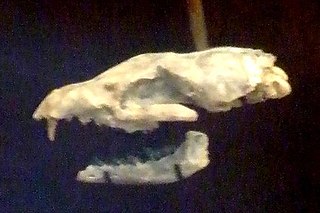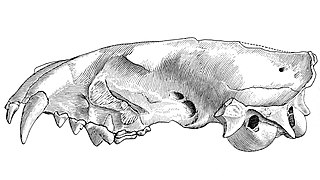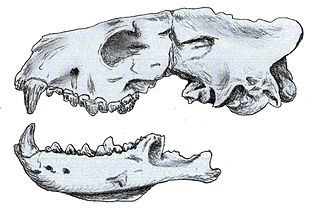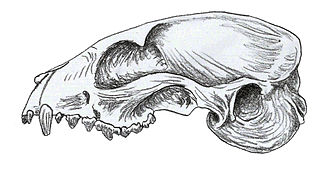
Canidae is a biological family of dog-like carnivorans, colloquially referred to as dogs, and constitutes a clade. A member of this family is also called a canid. The family includes three subfamilies: the Caninae, the extinct Borophaginae and Hesperocyoninae. The Caninae are known as canines, and include domestic dogs, wolves, coyotes, foxes, jackals and other species.

Canis is a genus of the Caninae which includes multiple extant species, such as wolves, dogs, coyotes, and golden jackals. Species of this genus are distinguished by their moderate to large size, their massive, well-developed skulls and dentition, long legs, and comparatively short ears and tails.

The side-striped jackal is a canine native to central and southern Africa.

Epicyon is a large, extinct, canid genus of the subfamily Borophaginae, native to North America. Epicyon existed for about 15 million years from the Hemingfordian age of the Early Miocene, to the Hemphillian of the Late Miocene. Epicyon haydeni is the largest known canid of all time, with the type species reaching 2.4 m (7.9 ft) in length, 90 cm (35 in) in shoulder height and approximately 100–125 kg (220–276 lb) in body mass. The largest known humerus specimen belonged to an individual weighing up to 170 kg (370 lb).

Hesperocyon is an extinct genus of canids that was endemic to North America, ranging from southern Canada to Colorado. It appeared during the Uintan age, –Bridgerian age (NALMA) of the Mid-Eocene– 42.5 Ma to 31.0 Ma. (AEO). Hesperocyon existed for approximately 11.5 million years.

Cynodesmus is an extinct genus of omnivorous canine which inhabited North America during the Oligocene living from 33.3—-26.3 Ma and existed for approximately 7 million years.

The Caninae, known as canines, are one of three subfamilies found within the canid family. The other two canid subfamilies are the extinct Borophaginae and Hesperocyoninae. The Caninae includes all living canids and their most recent fossil relatives. Their fossils were first found in North America and dated to the Oligocene era, then spreading to Asia at the end of the Miocene era, some 7 million to 8 million years ago.

The extinct Hesperocyoninae are one of three subfamilies found within the canid family. The other two canid subfamilies are the extinct Borophaginae and extant Caninae.

Archaeocyon is an extinct genus of the Borophaginae subfamily of canids native to North America. It lived during the Oligocene epoch 32-24 Ma., existing for approximately 8 million years. Species of Archaeocyon are among the earliest known borophagines, although a species of Otarocyon has a slightly earlier first appearance. Fossils have been found across the northern Great Plains and along the west coast of North America.

Cynarctus is an extinct genus of the Borophaginae subfamily of canids native to North America. The genus was first founded by W. D. Matthew in 1901, based from a pair of lower jaws, Cynarctus saxitilis, found in the Pawnee Creek Beds of Colorado. It lived during the Middle to Late Miocene 16.0—10.3 mya, existing for approximately 5.7 million years. Fossils have been uncovered in Colorado, California, Maryland, western Nebraska, and Texas. It was likely an omnivore, and lacked the bone-cracking adaptations found in some later borophagines. Newer findings have proved the genus to be described as a large dog-like raccoon, a result from combining characteristics from Canidae with Procyonidae.

Paraenhydrocyon is an extinct genus of bone crushing omnivorous early canid which inhabited North America during the Early Miocene, 24.8—20.4 Ma, existing for approximately 5 million years.

Enhydrocyon is an extinct genus of bone crushing canid which inhabited North America during the Oligocene and Early Miocene, 30.8—20.4 Ma, existing for approximately 11 million years.
Ectopocynus is an extinct genus of bone crushing canid which inhabited North America from the Oligocene to the Early Miocene. It lived from 33.3 to 16.0 Ma and existed for approximately 17.3 million years.
Prohesperocyon is an extinct genus of the first canid endemic to North America appearing during the Late Eocene around 36.6 mya (AEO).

Philotrox is an extinct monospecific genus of the Hesperocyoninae subfamily of early canids native to North America. It lived during the Oligocene, 30.8—26.3 Ma, existing for approximately 5 million years. In form, it was intermediate between the small Cynodesmus and the later Enhydrocyon, the first hypercarnivorous, "bone-cracking", canid.

Otarocyon is an extinct genus of the Borophaginae subfamily of canids native to North America. It lived during the Oligocene epoch, about 33.3—20.6 Ma. Fossils have been found only in Montana, Wyoming, and South Dakota.
Saxonella is a genus of extinct primate from the Paleocene Epoch, 66–56 Ma. The genus is present in the fossil record from around ~62–57 Ma. Saxonella has been found in fissure fillings in Walbeck, Germany as well as in the Paskapoo Formation in Alberta, Canada. Saxonella is one of five families within the superfamily Plesiadapoidae, which appears in the fossil record from the mid Paleocene to the early Eocene. Analyses of molars by paleontologists suggest that Saxonella most likely had a folivorous diet.

Simocyoninae is an extinct subfamily of Ailuridae. The taxonomic history of this group was complicated, as researchers placed various fossil caniform genera into the subfamily. In addition to Simocyon, there was also Oligobunis, Cephalogale, and Enhydrocyon. This subfamily was initially classified within the Canidae or dog family. This idea went even further in 1910 when American paleontologist Henry Fairfield Osborn considered dholes, African wild dogs, and bush dogs to be the only extant representation left of the simocyonines. This was in large part to the overall similarity in the morphology of their molars, which suggested a shared ancestry of hypercarnivory. This view point was not supported by European paleontologists who believed that Simocyon was more closely related to musteloids. Soon the Simocyoninae were found as extinct subfamily of procyonids, or members of the raccoon-family, due to similarity of the basicranium of these animals. This was supported by subsequent researchers. It was not until a more completed skull of a Simocyon found in north Shaanxi, China was described by Wang (1997) who found that Simocyoninae is closely related Ailurinae on the basis of cranial and dental characteristics.
Delotrochanter is an extinct genus of large-sized carnivoran mammals, belonging to the Amphicyonidae, that lived in the Great Plains of North America during the Oligocene to Early Miocene. This genus includes some of the largest and last surviving members of the subfamily Temnocyoninae. it furthermore possesses adaptions towards both bone-crushing and cursoriality.
Eoarctos is an extinct genus of arctoid carnivorans, known from the latest Eocene to early Oligocene of North Dakota and Nebraska. It is known from several remains, the most notable of which is the almost perfectly preserved skeleton of a large male. It was comparable in build and size to a fisher or small raccoon, with an estimated body mass of 4.3 kg, and possessed a variety of features that indicate a mix of terrestrial and scansorial locomotion. Its most notable feature is its unique dentition, with its massive premolars and hypocarnivorous molars, as well as its robust mandible, indicating that it consumed hard-shelled prey, possibly making it the oldest molluscivorous carnivoran known.














